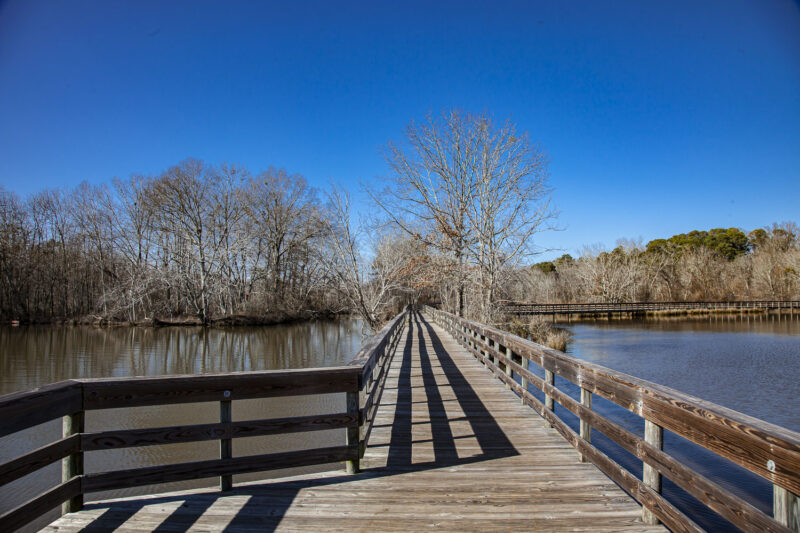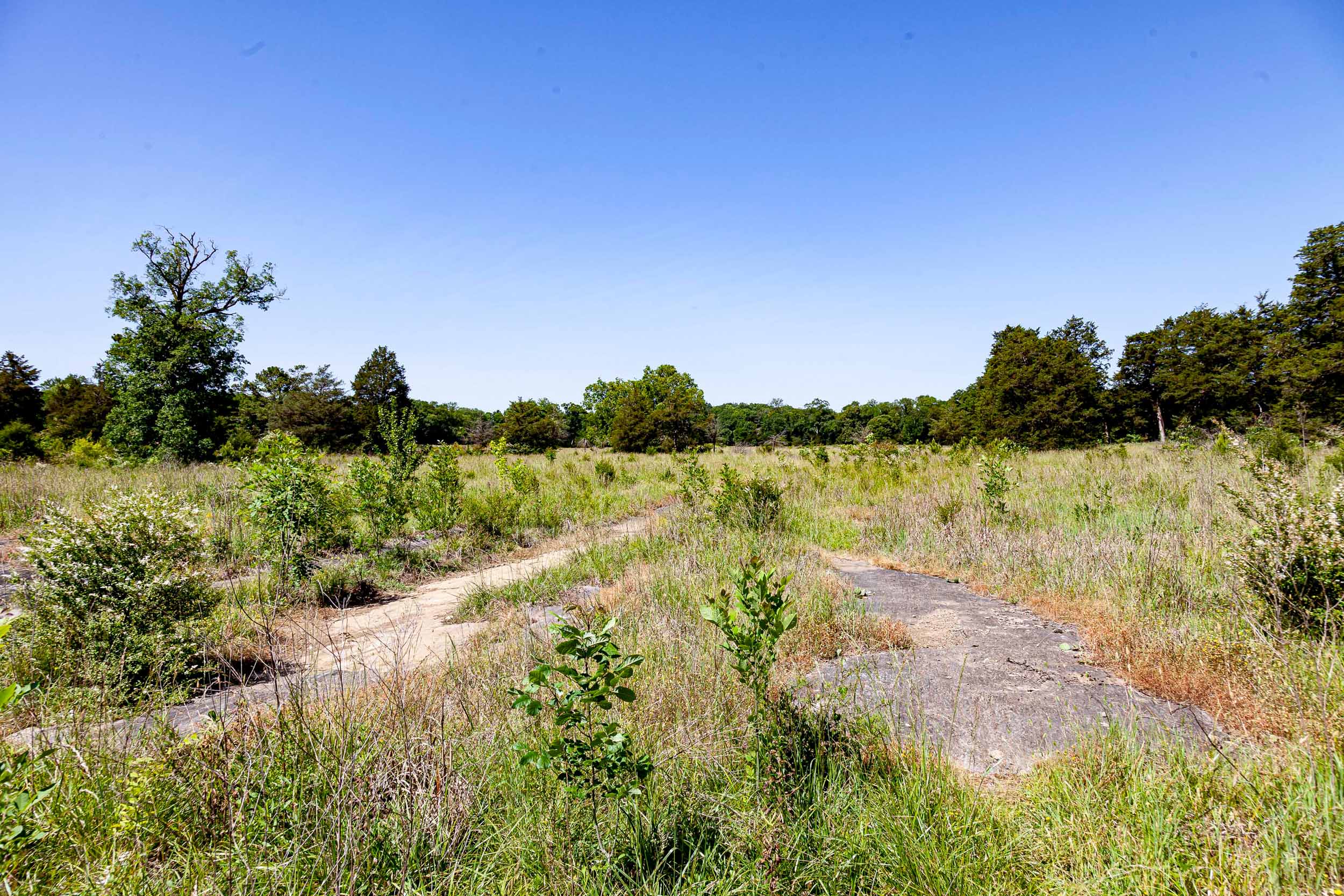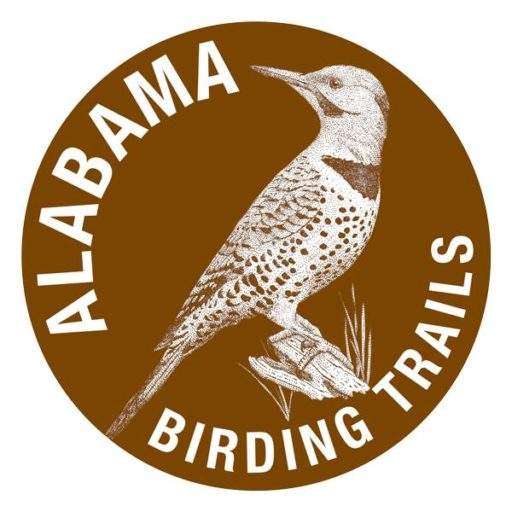
The Best Birding in Alabama
James D. Martin Wildlife Park. The shoreline trail connects to boardwalks that lead to several wooded islands in a 300-acre lake with views of wintering waterfowl, inland gulls, a host of wading birds, along with a wide variety of sparrow species. (GPS: 33.9973, -86.0083)

James D. Martin Wildlife Park
Ruffner Mountain Center and Wetlands. This thousand-acre park preserves the wooded slopes of Ruffner Mountain in the heart of Birmingham. The top of the mountain can be good for hawk watching, but the wetlands area is especially thick with neotropical migrants from spring through fall. Be sure to walk the level path located in the wetlands for your best chances at warblers and vireos.
(GPS: 33.55858, -86.6891 Center; 33.5596, -86.699 Wetlands)

Shelby County Loop. These three small parks south of Birmingham offer an easy day of birding a variety of habitats. Limestone Park (33.18579, -86.76353) has wetlands, grasslands, and Tupelo Gum swamp good for wading birds, swamp and marsh birds, grassland species, and some waterfowl in winter. Ebenezer Swamp Ecological Preserve (33.16777, -86.80946) located minutes away, offers an upland hardwood swamp, complete with accessible boardwalk extending into the swamp, with good opportunities in spring and summer to see breeding birds, including Prothonotary Warblers. Shoal Creek Park’s (33.124338, -86.85004) 167 acres of largely open lands and wooded margins is less than 10 minutes from Ebenezer Swamp. It’s great for Blue Grosbeaks, Summer Tanagers and Indigo Buntings during the spring and summer months. Loggerhead Shrike is a regular.

Shoal Creek Park
Talladega National Forest, Coleman Lake. A significant birding site, it boasts roadside looks at endangered Red-cockaded Woodpeckers. Red Crossbills, and even Golden Eagles, can sometimes be spotted here. The surrounding forest service roads provide outstanding opportunities for birding by car, driving the dirt roads slowly while watching (and listening) for birds with your windows down. Note: this site is closed in winter. (GPS: 33.78173 -85.55749)
Battleship Park. A military history park and museum on the western shore of Mobile Bay, the park offers a mix of habitats for waterbirds, grassland birds and urban species. As you drive into Battleship Park, look for a walkway to your right leading to an observation deck overlooking Pinto Pass. During low tide, this area is filled with herons, egrets and occasionally ibis, especially in late summer. Black-necked Stilt may be around any time of the year. In summer, Gull-billed Tern is present and Least Bittern often fly from one marshy area to the next. Hundreds of dowitchers gather here each spring. (GPS: 30.68529, -88.01731)
Bon Secour National Wildlife Refuge. Though the sites listed on the Coastal Birding Trail include three trails, the entire refuge is fair game for birds. In winter, look for Bufflehead, Common Loon and Horned Grebe. In spring, Osprey, Sandwich Tern and Northern Rough-winged Swallow are regulars. Expect to see Yellow-billed Cuckoo, Summer Tanager and Northern Parula during the summer. Chuck-will’s-widow and Great Horned Owl are commonly heard at dusk and dawn. (GPS: 30.24758, -87.82941)
Dauphin Island. One of the most popular places on the Gulf Coast for birding during spring and fall migration. As a classic migrant trap, it can be an overwhelming experience during a spring fallout when a cold front moving southward brings rain and northerly winds that cause birds to literally fall from the sky. Birding can be equally good in the fall but seems to linger longer. The island includes seven stops along the Coastal Birding Trail, but the entire island deserves an extended exploration! Be sure to stop by the small but remarkable Shell Mound Park for neotropical migrants, the airport for rails and other waders, and spend time visiting the beaches for plovers. Watch for other birders—you’ll know them because of the binoculars and the looks of wonder. (GPS:30.25586, W-88.10752)
Fort Morgan. This is a birding paradise, especially when adverse weather during spring migration can cause spectacular “fallouts” of colorful migrants. Many vagrant species find their way to this favorite birding spot as well, which can equal Dauphin Island in excitement. (GPS: 30.22951, -88.00827)
Gulf State Park. From Lake Shelby campgrounds to the fishing pier, this park offers everything from brackish marsh filled with wading birds to sparkling sandy beaches loaded with gulls, terns, willets, and plovers. Osprey soar overhead, Bald Eagles and Great Horned Owls nest in the winter months. Ten different sites are minutes apart. (GPS: 30.25611, -87.67858)
Village Point Park. At approximately 70 acres, this is the largest park in Daphne. A parking lot with bathrooms and a picnic pavilion marks the beginning of a 3,000- foot main trail that leads westward toward Mobile Bay. A pier and an extensive boardwalk follow along the bay, where visitors can walk north to Bayfront Park. Year-round residents include Great Horned and Barred owls, Red-bellied and Downy woodpeckers, Brown-headed Nuthatches and Blue-gray Gnatcatchers in the woods. Brown Pelicans and a wide variety of terns, herons, and gulls are typically found along the bay and marsh. In winter, many ducks can be seen in the bay, although a scope can be helpful to check out the distant ones. (GPS: 30.62872, -87.91215)
Wheeler National Wildlife Refuge. Productive in any season, winter is by far the most spectacular. Thousands of Sandhill Cranes gather, along with more than a dozen highly endangered Whooping Cranes. American White Pelicans flock here. With eight individual sites, including Arrowhead Landing, Beaverdam Swamp Boardwalk, and White Springs Dike, stop at the visitor center for current info, an accessible heated / cooled observation building, restrooms, and a wonderful interpretive center. (GPS: 34.5480, -86.9505)
Guntersville State Park. One of the premier birding areas in northeastern Alabama, this spot is particularly renowned in the winter months. Known for Eagle Awareness Weekends, held during January and February each year. During this time, look for dense populations of waterfowl, and the chance to spy a vagrant such as a Red-necked Grebe or an unusual gull. And, of course, Bald Eagles! (GPS: 34.3697, – 86.2169)
Monte Sano State Park. This iconic state park sits atop a remnant ridge of the Cumberland Plateau, giving a fantastic view of the surrounding valleys and plateaus that cover northeastern Alabama. These islands in the sky are covered in hardwood forest, and home to many neotropical migrants. Explore the trails and look and listen for Indigo Buntings, Great Crested Flycatchers, and Red-eyed Vireos. (GPS: 34.7470, -86.5104)
Winfred Thomas Agricultural Research Station. 900 acres of grasslands and agricultural fields provide a rare area of open country filled with native birds. Bird the area by making frequent stops, and look for Grasshopper Sparrows, Dickcissels, and Eastern Meadowlarks. Scan the open agriculture fields for other sparrows such as Chipping and Field. In winter, these fields host Northern Harriers and occasionally Short-eared Owls, which can be seen patrolling over the extensive grasslands. (GPS: 34.9025, -86.5596)
Wood Duck Nature Preserve of Opelika. The 73-acre park was created from a nutrient-rich intentional wetland, with an additional 7 acres of land including an old home-site. The park has become home to a significant population of birds, including a large population of Wood Ducks. Entrances at the old home-site and at the roadway both provide access to walking trails with varied birding opportunities. The home-site trail follows a heavily wooded stream to one of the preserve’s two observation blinds, overlooking open water. The trail accessed from the roadway is particularly bird-dense, and should be included in any birding visit to the area. The stream/marsh is a major bird oasis, especially during dry periods. All but two warbler species found in Alabama have been seen in the park in spring migration. (GPS: 32.65313, -85.43193)
Turtle Point Environmental Science Center. Common Grackles and Red-winged Blackbirds are attracted year-round to the diamond leaf and water oak, tupelo, and bald cypress that grow in the wetlands. Brewer’s Blackbirds join them in the winter. Belted Kingfishers are a common sight on Big Escambia Creek as are Great Blue Herons, Great Egrets, and Green Herons. Mississippi Kites forage just above the tree tops in spring and summer. Note: facility is closed during the summer. (GPS: 31.009364, -87.275679)
Perry Lakes Park. Woodland songbirds abound in the hardwood bottomlands at Perry Lakes, while the State Fish Hatcheries feature a variety of waders, shorebirds, and ducks and geese in winter. Don’t miss the view from the 100-foot-high birding tower, offering eye-to-eye views of songbirds, as well as excellent views of soaring raptors. (GPS: 32.69808, -87.259219)
Red-cockaded Woodpecker Colony. The Oakmulgee Division of the Talladega National Forest is home to the largest concentration of endangered Red-cockaded Woodpeckers in Alabama – over 100 groups, of the birds live here. Red-cockaded Woodpeckers are denizens of mature pine forests – particularly Longleaf pines, and stands of 100 acres or more of pines 75 years of age or older. The dirt roads leading through the forest are usually passable via car, but proceed with care. Nest sites change from year to year. (GPS: 32.99661, -87.31216)
Wehle Forever Wild Tract. Over 180 species have been documented here, providing excellent bird diversity. Two hiking trail loops provide easy access to multiple habitats including fire-maintained open pine-grassland savanna, a forested pond, and expansive bottomland hardwood forest corridors along a creek floodplain. Bachman’s Sparrow, which is common in the pine uplands of the property, can be heard singing throughout the spring and summer months. Northern Bobwhite, Common Ground-Dove, Red-headed Woodpecker, Acadian Flycatcher, Brown-headed Nuthatch, and Kentucky Warbler are just some other species of note here. (GPS: 32.04603, -85.46919)
Conecuh National Forest. The 83,000-acre forest of diverse habitats ranges from broad tracts of mature, open Longleaf Pine forest and dense pine-oak-hickory woodlands to extensive lily-pad swamps, early second-growth scrub, dense wet tangles and open lakes with manicured banks. Much of the forest may be accessed via paved highway. There are many well-maintained Forest Service roads leading to some of the wilder, less-visited parts of the forest. (GPS: 31.09241, -86.54123)
Eufaula National Wildlife Refuge. A patchwork of open fields, marshes, and impoundments bounded by Lake Eufaula to one side and mixed woods on the other, the refuge is first-rate for wetland songbirds and waders, as well as many species of waterfowl, particularly in winter. Be sure to stop by Lakepoint State Park right next door. (GPS: 31.98787, -85.10375)
Find all the sites on the birding trails below!
